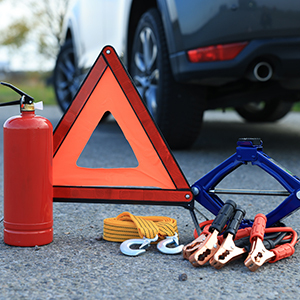Emergency Essentials: Car First Aid Kits

Emergencies can occur without warning, and being prepared can mean the difference between safety and danger on the road. Whether you experience a breakdown, get caught in severe weather or are involved in an accident, having essential emergency supplies in your vehicle offers peace of mind and can save lives.
Assembling a comprehensive car emergency kit is one of the simplest, most effective steps you can take to protect yourself and others. A well-stocked kit not only helps you to manage injuries but also allows you to respond quickly to common roadside issues.
Why You Should Have a Car Emergency Kit
Unexpected situations on the road can leave drivers vulnerable, especially when help is delayed. An emergency kit provides critical tools to handle a wide range of challenges and keeps you calm and in control.
- Mechanical Failures: Jumper cables or a portable power source can restart a dead battery, while a tire repair kit can help you fix a flat and avoid an expensive tow.
- Severe Weather: Blankets, extra clothing and hand warmers help preserve body heat during snowstorms or freezing temperatures until assistance arrives.
- Accidents and Visibility: A first aid kit allows you to treat minor injuries immediately after an accident. And flares and reflective triangles can warn other drivers that your vehicle is stopped, reducing the risk of secondary collisions.
- Confidence and Cost Savings: Being equipped to handle small problems on your own saves time and money and lessens the stress of being stranded.
- Helping Others: With a well-equipped kit, you can assist other motorists by providing a jump start, basic medical care or even bottled water.
10 Essential Items for Your Car Emergency Kit
When putting together a vehicle emergency kit, include multipurpose items that help with first aid, basic vehicle repairs, visibility and comfort during an extended wait for assistance.
- First Aid Kit: Stock your kit with adhesive bandages, antiseptic wipes, sterile gauze and pain relievers so you can handle minor injuries on the spot.
- Emergency Radio: A battery-powered or hand-crank radio can help you stay informed about emergency alerts, weather warnings and crucial instructions from authorities when cell service is unavailable.
- Flashlight and Extra Batteries: A flashlight provides visibility at night for inspecting your vehicle or signaling for help without draining your car battery.
- Jumper Cables or Portable Power Pack: Dead batteries are a common roadside emergency, but having the right equipment can help you get yourself back on the road faster.
- Water and Non-Perishable Food: Keep at least one gallon of drinking water per person and high-energy snacks such as nuts or granola bars.
- Blankets and Warm Clothing: If you drive in wintry weather, you should have gear to help you keep warm if you get stranded. Mylar blankets and hand warmers are compact and effective tools to put in your kit.
- Tire Repair Kit and Inflator: If you don't have a spare tire, a tire repair kit with a sealant, patching tool or portable inflator can temporarily fix a flat tire so you can reach a repair shop safely.
- Road Flares or Reflective Triangles: These emergency warning devices increase the visibility of disabled vehicles, reducing the risk of a secondary accident.
- Shovel and Traction Material: A small shovel and sand, salt or cat litter can help free a vehicle stuck in snow, ice or mud.
- Portable Power Bank or Car Charger: Bring a way to keep your phone charged so you can call for help even if your car's battery dies.
Additional Items for Emergency Preparedness
Beyond the essentials, a few extra supplies can make difficult situations more manageable. A multi-tool with scissors and pliers can be invaluable for quick repairs.
Cash and coins can help you buy things you need in situations where you can't pay electronically. A rain poncho protects you when stepping outside in bad weather. And duct tape can provide a temporary fix for leaks or loose parts.
If you have kids, it's also a good idea to have some non-digital distractions on hand, like a deck of cards or small books, to keep them calm during long waits.
Car Safety Tips
- Keep your gas tank at least half full to prevent fuel-line freezing and make sure you can handle unexpected detours or evacuations.
- Avoid driving through flooded areas. Just six inches of water can cause a car to stall, and a foot of moving water can be enough to carry a car away.
- If a power line falls on your vehicle, stay inside until professionals confirm that it's safe to exit.
- Never use cruise control on wet or icy roads.
- Stay alert, minimize distractions and get adequate rest before long drives to prevent fatigue-related accidents.
Prepare Your Car for Emergencies
Preventive maintenance is the first line of defense against roadside emergencies. Before long trips or at the start of a severe weather season, have a mechanic inspect key components such as:
- Battery, ignition and brake systems
- Antifreeze and fluid levels (including oil and windshield washer fluid)
- Lights, heater and defroster
- Exhaust system (to prevent carbon monoxide leaks)
Pair regular maintenance with making or reviewing your emergency plan. Know how to receive local alerts, and discuss an emergency communication strategy with your family before a disaster happens.
- Emergency Preparedness Supplies and Steps
- Be Prepared With Emergency Supply Kits
- Comprehensive Emergency Kit Checklist
- What to Do When Your Vehicle Breaks Down
- Winter Survival Guide: How to Stay Alive in Your Car
- Vehicle Preparedness Guide
- Florida Driving Training Course
- Seven Things to Keep in Your Car
- Get Your Vehicle Ready Before Winter Storms
- Florida Learner's Permit Class
- Survival Basics: Emergency Kits
- TLSAE Drug and Alcohol Course
- Roadside Emergency Kits
- Winter Driving Safety
- Online DETS Course

